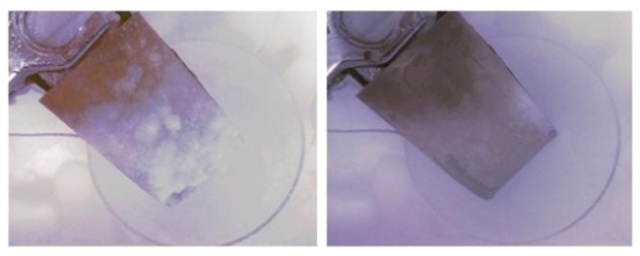Jan 28 2016
Researchers from Rice University have developed a thin coating of graphene nanoribbons in epoxy that has been effective in melting ice on the blades of helicopters.
A new paper in ACS Applied Materials and Interfaces - a journal from the American Chemical Society - stated that the coating, invented by the Rice lab of chemist James Tour, could efficiently de-ice the surfaces of transmission lines, wind turbines, aircraft, and various other surfaces exposed to winter weather.
 Rice University scientists embedded graphene nanoribbon-infused epoxy in a section of helicopter blade to test its ability to remove ice through Joule heating. (Credit: Tour Group/Rice University)
Rice University scientists embedded graphene nanoribbon-infused epoxy in a section of helicopter blade to test its ability to remove ice through Joule heating. (Credit: Tour Group/Rice University)
During the test, centimeter-thick ice from a static helicopter rotor blade in an environment of -4°F was melted. The surface receives electrothermal heat as a result of a small voltage, and this process is known as Joule heating.
Rice University developed a process called unzipping nanotubes, this process is used to commercially develop the highly conductive nanoribbons. Instead of producing expensive and large graphene sheets, the Rice lab discovered that the nanoribbons present in composites are capable of interconnecting and conducting electricity throughout the material, with loadings that are a lot lower than the conventional requirements.
Experiments conducted earlier highlighted that nanoribbons present in films are applicable to de-ice glass and radar domes, as these films are capable of being transparent to the human eye.
Applying this composite to wings could save time and money at airports where the glycol-based chemicals now used to de-ice aircraft are also an environmental concern.
James Tour, Chemist, Rice University
The lab tests revealed that the nanoribbons did not exceed 5% of the composite. Rice graduate student Abdul-Rahman Raji and his team of researchers spread a thin composite coating on a section of a rotor blade provided by a helicopter manufacturer. The team then replaced a thermally conductive nickel abrasion sleeve used as a leading edge on the blade. The composite was heated to more than 200°F.
Tour stated that for the wings or blades in motion, the thin water layer that initially forms between the hot composite and the surface should be enough to slacken the ice and allow it to fall before it can completely melt. A robust composite remained in temperatures up to nearly 600°F. The coating can protect an aircraft from lightning strikes and can be used as an additional electromagnetic shielding layer.
Co-authors of the paper are Rice undergraduates Tanvi Varadhachary, graduate student Tuo Wang, postdoctoral researchers Jian Lin and Yongsung Ji, alumni Kewang Nan, Yu Zhu of the University of Akron and Bostjan Genorio of the University of Ljubljana, Slovenia, and research scientist Carter Kittrell.
Tour is the T.T. and W.F. Chao Chair in Chemistry as well as a professor of computer science and of materials science and nanoengineering.
The research was supported by the Air Force Office of Scientific Research and Carson Helicopter.